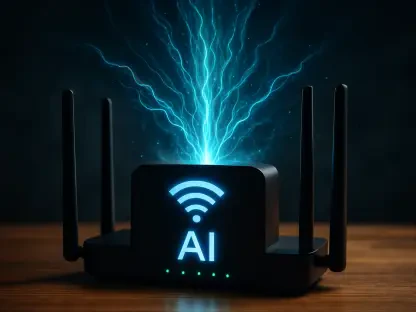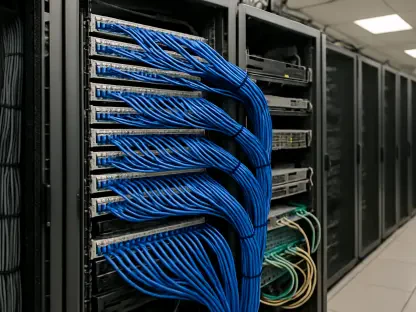The University of Notre Dame has recently achieved a significant technological milestone by becoming the first college or university in the United States to implement a Wi-Fi 6E network on campus, including their iconic football stadium. This groundbreaking upgrade leverages the 6GHz wireless spectrum, promising enhanced wireless coverage, increased bandwidth, and a range of advanced features and benefits aimed at enriching the experience for students, faculty, administrators, and fans alike. This development is positioned not only to elevate the fan experience but also to establish the institution as a leader in connectivity and technological innovation in higher education.
Enhanced Fan Experience
One of the primary motivations behind the deployment of Wi-Fi 6E in Notre Dame’s stadium was to upgrade the digital experience for the 80,000 fans attending games. The advanced network enables several fan-centric features, including ticketless entry, remote ordering, and live streaming. Fans can enter the stadium seamlessly without the need for physical tickets, reducing the hassle and wait times associated with traditional ticketing methods. Additionally, attendees can order food and beverages from concession stands remotely, which significantly reduces wait times and enhances convenience.
The ability to stream real-time stats and video chats from Fighting Irish Media provides fans with a more immersive and engaging way to follow the game. They no longer miss out on any action while waiting in line for snacks or drinks. These features collectively contribute to a more enjoyable and efficient game-day experience. The high-speed connectivity allows fans to share their experiences on social media without lag or interruption, fostering a more connected and engaging community of supporters.
The seamless integration of these digital services not only enhances the fan experience but also demonstrates Notre Dame’s commitment to leveraging technology to improve overall operational efficiency. The introduction of Wi-Fi 6E sets a new standard for stadium connectivity, ensuring that fans have access to the best possible digital amenities, enhancing their overall satisfaction with their game-day experience.
Substantial Bandwidth Improvement
The new Wi-Fi network is designed to handle a maximum capacity of up to 40Gbps, more than tripling the bandwidth of Notre Dame’s previous network. During the team’s first game on September 28, the network comfortably supported a peak load of 22.37Gbps. This substantial increase in bandwidth ensures that the network can handle the high demand for connectivity during large events without compromising performance. The enhanced bandwidth also supports a wide range of applications and services, from streaming high-definition video to supporting the connectivity needs of thousands of devices simultaneously.
This improvement is crucial for maintaining a high-quality user experience, especially in a densely populated environment like a football stadium. Attendees can enjoy uninterrupted streaming, seamless browsing, and reliable communication, enhancing their overall satisfaction. The capability to handle such high bandwidth also opens up new possibilities for future technological advancements and applications, providing Notre Dame with a robust infrastructure that can adapt to evolving needs.
By tripling the bandwidth, the university ensures that its technological infrastructure can support not only current demands but also future growth. This proactive approach reflects Notre Dame’s commitment to staying ahead of technological advancements and providing the best possible experience for its community. The increased bandwidth enhances not only the stadium experience but also benefits the entire campus by providing a more reliable and efficient network for various activities and services.
Holistic Campus Connectivity
The enhancement extends beyond the stadium, serving as the central hub for an expansion of Wi-Fi 6E across the Notre Dame campus. This ensures high-speed connectivity for students, faculty, and administrators, facilitating diverse academic and research projects. The comprehensive coverage provided by the new network supports a wide range of activities, from online learning and research to administrative tasks and campus communications. By extending the benefits of Wi-Fi 6E to the entire campus, Notre Dame is ensuring that all members of its community can take advantage of the latest advancements in wireless technology.
This holistic approach to connectivity is essential for creating a modern, efficient, and connected campus environment. High-speed internet access across campus supports academic collaboration, enabling students and faculty to engage in real-time communication and resource sharing, regardless of their location. Additionally, robust wireless connectivity enhances the university’s operational efficiency, streamlining administrative processes and improving overall campus management.
By integrating Wi-Fi 6E throughout the campus, Notre Dame is creating a cohesive and interconnected digital ecosystem that promotes innovation and collaboration. Researchers and students can leverage the enhanced connectivity for data-intensive projects, real-time analysis, and collaborative endeavors. This comprehensive network upgrade reflects the university’s forward-thinking approach to technology, positioning Notre Dame as a leader in connectivity and educational excellence.
Innovative Applications
The project opens doors to innovative technological applications, such as utilizing IoT devices to monitor grass growth on the field. This is indicative of Notre Dame’s broader objective of harnessing the power of advanced technologies to benefit the university community. For instance, although the football field has artificial turf, real grass is laid down for special events. Wi-Fi-enabled sensors can provide critical data on such developments. These sensors can monitor soil moisture levels, temperature, and other environmental factors to ensure optimal conditions for grass growth, enhancing the quality and safety of the playing field.
Notre Dame also plans to integrate virtual reality features into the fan experience, allowing real-time tracking of plays and player highlights. This innovative approach allows fans to immerse themselves in the game, experiencing it from different perspectives through VR technology. Additionally, event personnel can leverage network data to optimize crowd control measures and enhance security monitoring during events. These innovative applications demonstrate the potential of Wi-Fi 6E to transform various aspects of campus life and operations.
The use of advanced technologies such as IoT and VR enhances the overall experience for both fans and the university community, providing valuable data and insights that can improve operations and decision-making. By embracing these technologies, Notre Dame is showcasing its commitment to innovation and its dedication to leveraging cutting-edge solutions to enhance the overall campus experience.
Academic Research and Collaboration
The powerful Wi-Fi 6E infrastructure positions Notre Dame’s Wireless Institute to use the upgraded campus as a live lab for conducting cutting-edge research into IoT, augmented reality, and artificial intelligence. This positions the campus at the forefront of academic research and technological advancement. The enhanced connectivity provided by Wi-Fi 6E supports a wide range of research activities, from data collection and analysis to the development and testing of new technologies.
By leveraging the capabilities of Wi-Fi 6E, Notre Dame is creating new opportunities for collaboration and innovation. Researchers can work together more effectively, share data and resources more easily, and explore new frontiers in technology and science. This commitment to research and collaboration is essential for maintaining Notre Dame’s position as a leader in higher education. The ability to conduct research in a real-world environment with advanced connectivity provides invaluable insights and accelerates the development of new technologies and applications.
The enhanced network allows for seamless communication and collaboration between researchers, students, and faculty, fostering an environment of innovation and discovery. By transforming the campus into a living lab, Notre Dame is not only enhancing its research capabilities but also preparing the next generation of innovators and technology leaders.
Challenges and Solutions
Notre Dame’s stadium, constructed in 1930, presents unique challenges for modern wireless infrastructure due to its thick concrete walls, which can impede wireless signals. Moreover, the busy event schedule required the IT team to be strategic about installation times to avoid disruptions. To overcome these challenges, the team adopted creative methods such as using 3D printing to craft enclosures for the access points, which were discreetly integrated into the stadium’s existing structures.
The actively managed installation of Aruba outdoor access points was key to achieving coverage throughout the stadium. These access points were strategically placed to ensure optimal coverage and connectivity, even in areas with challenging architectural constraints. To accommodate the advanced Wi-Fi capabilities, the backend network switches were upgraded. The introduction of 130 new switches furnished with smart-rate multi-gigabit ports and Power-over-Ethernet (POE) capabilities (up to 90 watts per port) supported the high power requirements of the 6GHz band.
By addressing these challenges head-on, Notre Dame was able to implement a state-of-the-art network that provides reliable and high-speed connectivity throughout the stadium. The strategic placement and innovative solutions ensured that the network could handle the demands of large crowds without compromising performance. This meticulous approach to installation and management highlights Notre Dame’s commitment to excellence and its proactive approach to overcoming challenges in pursuit of technological advancement.
Broader Implications and Future Outlook
The University of Notre Dame has reached a notable technological milestone by becoming the first college or university in the United States to implement a Wi-Fi 6E network on its campus. This includes the implementation at their famous football stadium. Utilizing the 6GHz wireless spectrum, this groundbreaking upgrade offers improved wireless coverage, increased bandwidth, and a variety of advanced features aimed at enhancing the experience for students, faculty, administrators, and fans.
This initiative marks a significant advancement for Notre Dame, positioning the institution at the forefront of connectivity and technological innovation within higher education. With the adoption of Wi-Fi 6E, the university is set to deliver superior connectivity, which is expected to transform the academic and social environment on campus.
The enhanced network will support a wider array of devices and more robust usage, accommodating the ever-growing demand for digital resources and connectivity. This upgrade is not just limited to the academic buildings but is extended to the football stadium, thereby elevating the overall fan experience during game days.
By leading in this technological innovation, Notre Dame sets a new standard in the educational sector, showcasing how modern technology can be leveraged to benefit a diverse group of stakeholders, from students to sports enthusiasts. The move underscores the university’s commitment to fostering an environment of growth, learning, and advanced connectivity.









